
There are places in Crete that we call magical. They are usually distinguished by a specific history or location in remote corners of the island. One such place is the over 1000-year-old Byzantine church of Agios Pavlos, erected on the remote Selouda beach in the south of Crete. Although we have already seen various photos of this corner, it made a stunning impression on us live. This church has been on our list of places to visit for a long time and we finally managed to implement this plan. The remote location and the logistical effort that must be put in to get here is a guarantee that few people from among tourists spending their holidays in Crete reach Agios Pavlos.
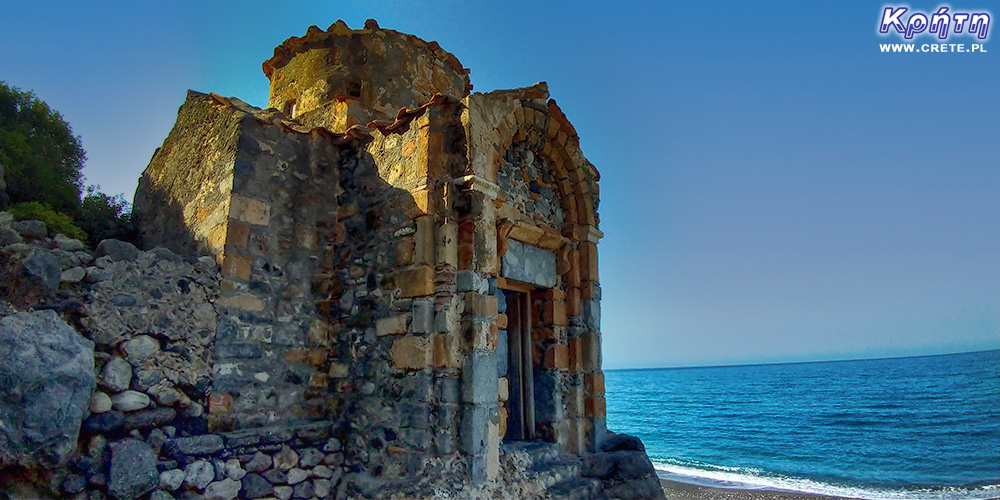
If someone would like to get here, they have several options to choose from. The first is the E4 hike from Agia Roumeli. This is by far the fastest and easiest route. However, to do it, you should spend the night in Agia Roumeli so that you can go out on the trail in the early morning. This option is especially recommended if you don't want to stop at Agios Pavlos, but go all the way to Loutro.
If the goal is only a trip to the church, you can skip the night and come to Agia Roumeli with the first ferry going here from Paleochora. However, such a solution means that the start of the trek will be postponed to around 10 am. With the option of going only to Agios Pavlos and returning to Agia Roumeli, such a march is perfectly feasible. However, with the option of going all the way to Loutro and returning by ferry to Paleochora, the plan will become unrealistic due to restrictions on ferries.
Agios Pavlos is approximately 4 km from Agia Roumeli, which, depending on the pace and the number of stops for photos, can take from 1.5 to 2 hours. The difficulty of the trail is moderate and the terrain is varied. In many places, the path leads through a sandy beach, which turns into a rocky beach and then turns into a sandy one again. We don't know what's worse: In several places you have to overcome larger stones, in others you have to take into account the necessity to walk along a path leading along a steep cliff. We also came across one place where the path was a bit dirty.
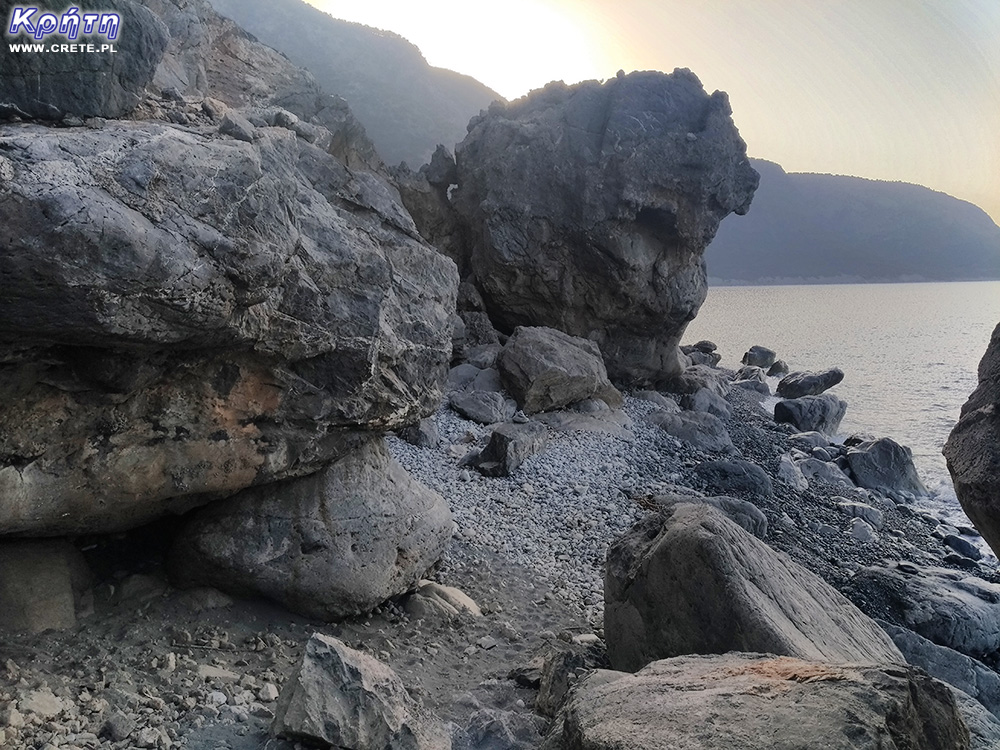 Part of the E4 route between Agia Roumeli and Agios Pavlos
Part of the E4 route between Agia Roumeli and Agios Pavlos
The second option is to reach Agios Pavlos by taking the trail from Loutro. However, in this case you have to take into account a much longer distance (about 9 km one way), and thus a longer time needed to walk. When departing from Loutro, an overnight stay in this town is a must. The first ferries from Chora Sfakion arrive in Loutro quite late, so there is not enough time for the trip and possible return to the same place. Additionally, you have to take into account that the trail from Loutro is quite tiring. Particularly exhausting is the rocky part of the path just beyond Marmara Beach. There is no place here to shelter from the sun. To make matters worse, it is quite a long fragment, which can be a pain in the summer months.
Another difficult part of this part of the trail, and perhaps a challenge for some people, is the steep and exposed section between the Likos and Marmara beaches.
If someone would like to implement this scenario, after reaching Agios Pavlos, the most sensible option is to continue the march to Agia Roumeli, where on the next morning you can take the ferry back to Loutro or further to Chora Sfakion.
Apparently, you can also get to Agios Pavlos by a rented boat from Agia Roumeli. However, we did not look for information on this option, so we will not suggest anything specific. Besides, we are of the opinion that excessive simplifications take away the magic of every more beautiful place. Let us stay, therefore, on hiking full of challenges.
Theoretically, there is one more option for a trip to Agios Pavlos with Agia Roumeli that does not require an additional overnight stay. If someone, after crossing Samaria, feels unsatisfied, he can treat himself to an additional walk to Selouda as a bonus. However, there are two conditions for implementing this variant. The first is the time: you need to leave Samaria around 1 p.m., to enter the trail to Agios Pavlos after a short rest and then return to Agia Roumeli before the departure of the return ferry to Paleochora or Chora Sfakion. Condition number two is very good physical condition, which will allow you to walk the extra few kilometers painlessly. This is a high bar, because most of the people who have already passed Samaria dream only of bathing and drinking beer, not another walk. The more so because in the summer the heat and scorching sun, which strongly affects this trail in the afternoon, can be very hard. It is worth taking this into account when assessing your abilities.
Regardless of the selected scenario, you always need to take into account several variables when planning this transition. First of all, where are you starting from and at what point do you want to end the march, and where do you finally go. The second important issue is the current timetables of ferry connections. These are the variables that will help you develop an action plan.
We stayed at Agia Roumeli for a few nights, so we took the opportunity to walk a 13 km stretch of the trail between Agia Roumeli and Loutro. In carrying out this trip, we simply "passed" Agios Pavlos along the way.
In order to avoid the tiring sun and high temperature as much as possible, we set off on the trail just after 7 am. Thanks to this, we covered the entire section between Agia Roumeli and Agios Pavlos in a pleasant shade. An additional advantage of such an early season was a slightly dark, gray atmosphere visible both in the pictures and in the film. We reached Agios Pavlos after 2 hours of walking. As indicated above - this distance can be covered faster. However, we are not in favor of crossing the trails on time, and on the hiking routes we always take a lot of photos and record videos, which significantly extends our transition times.
Then, from Selouda Beach, where Agios Pavlos is located, we continued on to Loutro, where at the end of the day we took the last ferry back to Agia Roumeli. A small note here - the last ferry does not go further to Paleochora, but stays overnight in Agia Roumeli.
To reach Seloud, the first steps were directed to a small tavern, which is located in front of the church. It's the only place in this neighborhood for civilization and basic amenities. Fortunately, the owners did not sleep anymore and gave us strong coffee, which immediately got us on our feet. The sparse decor of the tavern fully reflects the atmosphere of this place, which can be boiled down to a few words: simple offer, no commercialism. It is a very characteristic atmosphere for this type of place that is located at the proverbial end of the world. When we finished drinking coffee and went to see the church, we were caught up with the sun, the first rays of which began to shyly brush its stone walls.
The Church of Agios Pavlos administratively belongs to the deserted village of Agios Ioannis located a few hundred meters above the beach. If you tried to spot it from a distance, it would probably be difficult as it was built from nearby stones. The colorful facade works like camouflage, so from a distance it's hard to distinguish the church from the surrounding rocks and the sea.
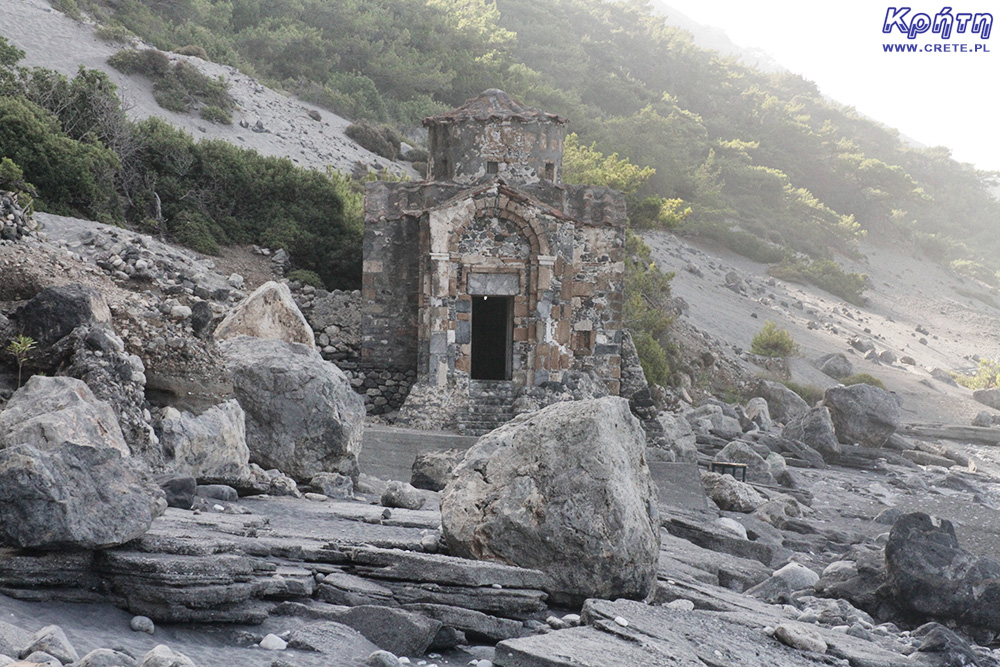
The question immediately arises "what is this church doing here?" It is not often that you see such buildings erected on the beach itself, among dark gray sand, pieces of gray-brown rocks and stones. It is said to have been erected around 1040 on the site where the apostle Paul baptized the first Christians during his trip to Rome. The local Saint John the Hermit, who lived in this area to stay away from other people, was to contribute to the creation of the church.
The church is built on a cross plan with a central dome. The inner part of the vault is decorated with heavily damaged frescoes probably from the 13th century, apparently not served by the vicinity of the seaside air. The rest of the decor is also very modest and austere. It is one of the characteristic features of this type of churches.
Selouda Beach, where the church stands, is covered with gray sand and pebbles, and above it grows a charming pine forest. It is a beautiful and long but completely wild beach with no typical infrastructure. If, after reaching this place, you would like to spend some time on it, you must bring all beach accessories with you.
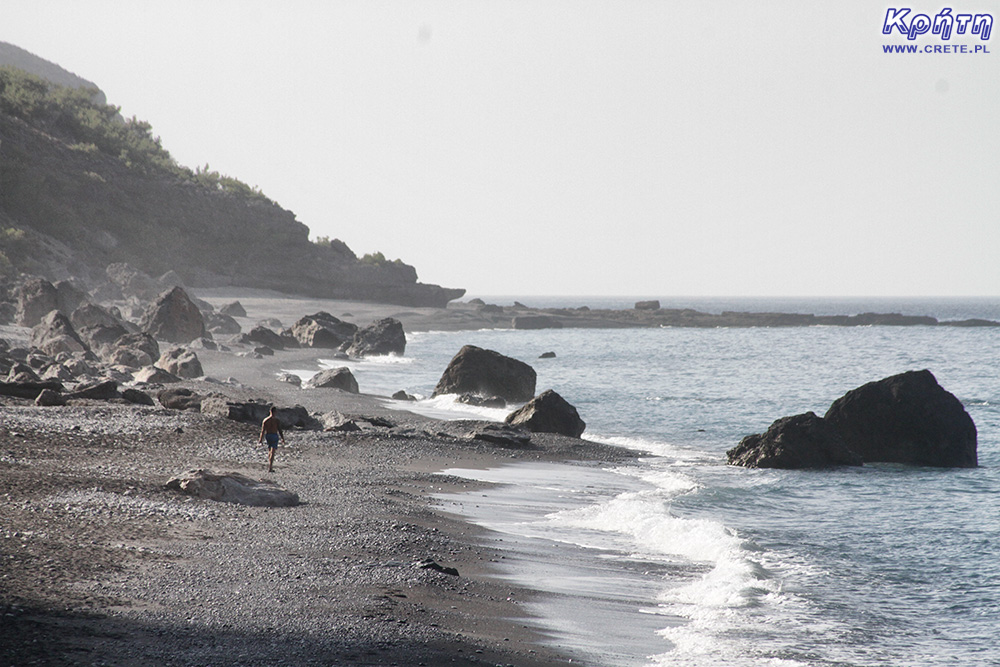 Selouda Beach
Selouda Beach
Finally, a small note for people who would like to go further to Loutro from Agios Pavlos. At this point, the E4 route does not run along the beach, do not go any further because it is a dead end. This beach is over a kilometer long, so taking the wrong path will mean extra walking distance. To get back on the trail, you have to go up the mountain right next to the church of Agios Pavlos. As you go this way, you will return to the path along the top of the dune. If you would go further along the beach itself, then it would be impossible to take a shortcut to the trail. In the further section of the E4, it delves into the pine forest located above. The terrain becomes much steeper, and the trail itself definitely goes above the sea coast.
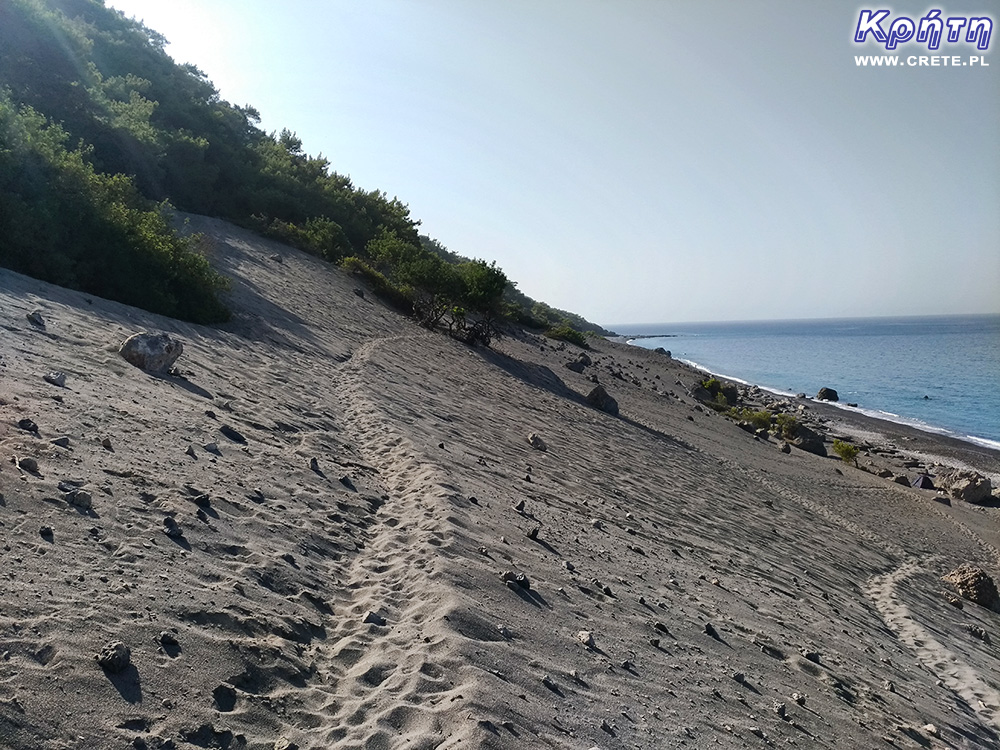 The E4 route at Selouda Beach
The E4 route at Selouda Beach
↤ click the appropriate part of the island to change the bottom map
W 2002 roku Falasarna zdobyła tytuł najlepszej plaży w Grecji. Wyróżnienie to nie jest bynajmniej przypadkowe, gdyż miejsce to jak na standardy Krety jest naprawdę unikalne.
Elafonisi is a small island located at the end of the southwestern edge of Crete. A characteristic feature of Elafonisi is the shallow lagoon connecting it with Crete.
Elafonisi is a small island located at the end of the southwestern edge of Crete. A characteristic feature of Elafonisi is the shallow lagoon connecting it with Crete.
This is the second largest airport (IATA code: CHQ) in Crete. In 2010, the airport in Chania served a total of over 1.65 million passengers.
Chania (Χανιά) is the second largest (after Heraklion) city of Crete. The biggest advantage of Chania is the area of the Old Town and the beautiful Venetian Harbor.
Aptera is a city whose history dates back to at least a thousand years before our era. In the peak period, about 20,000 lived in it. people, of which only 1/5 were free people.
Chania (Χανιά) is the second largest (after Heraklion) city of Crete. The biggest advantage of Chania is the area of the Old Town and the beautiful Venetian Harbor.
The genesis of the name of this poviat will not surprise anybody who will break the road from the Imbros gorge to Hora Sfakion.
Frangokastello is a small fortress that was built by the Venetians over four years from 1371. Initially, the castle was named after Saint Nikitas.
(Χρυσοσκαλίτισσα) The Church of the Blessed Virgin Mary with the Golden Step from the 17th century is the westernmost church building of this type.
(Χρυσοσκαλίτισσα) The Church of the Blessed Virgin Mary with the Golden Step from the 17th century is the westernmost church building of this type.
Omalos is a perfect starting point for exploring the Samaria Gorge. Located over 1,100 m above sea level extends over an area of 25 km2. Its size corresponds more or less to the size of the Lasithi Plateau.
Located 47 km from the city of Chania, it is the only freshwater lake in Crete. Its area is about 580 thousand. sqm. and the maximum depth is about 45 meters
Omalos is a perfect starting point for exploring the Samaria Gorge. Located over 1,100 m above sea level extends over an area of 25 km2. Its size corresponds more or less to the size of the Lasithi Plateau.
The steel crossing, which in the central part is separated from the ground by nearly 150 m, is at the leading position of the places where the longest bungee jumps are made.
Chania (Χανιά) is the second largest (after Heraklion) city of Crete. The biggest advantage of Chania is the area of the Old Town and the beautiful Venetian Harbor.
The genesis of the name of this poviat will not surprise anybody who will break the road from the Imbros gorge to Hora Sfakion. Word
This is the second largest airport (IATA code: CHQ) in Crete. In 2010, the airport in Chania served a total of over 1.65 million passengers.
Chora Sfakion is an extremely picturesque mountain village of the mountainous and wild Sfakia region
Loutro is famous for the fact that you can get to it only from the sea or walk on the mountain trail, because there is no other road here.
Stavros used to be a small fishing village. Today, it is primarily a tourist destination, but in a positive sense.
The cave is less than 1 km from Moni Gouvernetou Monastery. You will reach it using the pedestrian trail that has been marked out along the slope of the Avlaki Gorge.
Balos is one of Crete's flagship beaches if not all of Greece. We can assure you that the landscapes you see during your trip to Balos will remain with you for a very long time.
Moni Katholiko is probably the oldest and most spectacular monastery in Crete. It is located 20 km north-east of Chania.
The Orthodox monastery of Agia Triada, located on the northern part of the Akrotiri peninsula, is one of the most beautiful and richest monasteries in Crete.
The Orthodox monastery of Agia Triada, located on the northern part of the Akrotiri peninsula, is one of the most beautiful and richest monasteries in Crete.
Gouverneto Monastery is probably the oldest active Greek Catholic monastery located on the Akrotiri peninsula near Chania.
The length of the trail leading through this place is about 8 kilometers and the difference in altitude is about 600m.
Agia Roumeli znajduje się na południowym wybrzeżu Prefektury Chania, pomiędzy miejscowościami Chora Sfakion i Paleochora.
Until the early nineties, this place was known only to few tourists and local residents.
Paleochora is a quite well-organized tourist town, with a beautiful large sandy beach
Ruiny starożytnego miasta Lissos znajdują się około 3,5 km od miejscowości Sougia na południowym wybrzeżu Krety.
Samaria is one of the most important tourist attractions located in the western part of Crete.
On the north-western coast of Crete, at the foot of the Gramovous peninsula, there are ruins of the ancient port of Korikos, later known as Falassarna.
Krios Beach is located about 9 km west of Paleochora and it is also the last beach on this stretch of the southern coast
Between the villages of Topolia and Koutsamatados there is an interesting cave known as Agia Sofia
Milia is an authentic mountain settlement, which most probably dates from about the seventeenth century.
On the edge of the village of Potamida grows a complex of clay mounds called Komolithi (Komolithoi)
Grammeno (Γραμμένο) is a beach that can be counted among one of the best and most beautiful beaches in this part of Crete.
Platanias is a popular tourist destination. It is here that there are very interesting tunnels from World War II.
Polyrinia was one of the most important city-states of western Crete during the Hellenistic and Roman periods. It was built amphitheater on a steep hill, rising to a height of 481 meters above sea level
The Agia Irini gorge, just a short distance from the village of Sougia, is one of the most popular hiking destinations.
The island of Gramvousa, or in fact Imeri Gramvousa (Ήμερη Γραμβούσα), is an inseparable point of a trip that combines a stay in the Balos Lagoon with visiting the remains of a fortress located on the top of the island of Imeri Gramovousa.
Agia Roumeli is located on the south coast of Chania Prefecture, between Chora Sfakion and Paleochora.
The Byzantine church of Agios Pavlos was erected on the remote Selouda Beach in the south of Crete.
There is a beach in Crete that literally makes some people shiver. This place is Seitan Limania which can be translated as Satan's Ports or Cursed Ports.
Aspri Limni means White Lake, although the lake is just a conventional name. Under this term there is a small bay.
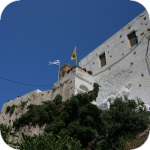
Redirected from the page - Church with the Golden Step. The Church of the Blessed Virgin Mary with the Golden Step dating from the seventeenth century is the westernmost sacred building of this type, 9 kilometers away from Elafonissi. There is no way to overlook the convent leading to this monastery, because Hrisoskalitissas is about half a kilometer from the main road leading from Kissamos towards Elafonisi. It is worth joining this church with a rest on the most famous beach of Crete. The main advantage of Hrisoskalitissas, for which it is worth seeing it is a beautiful location on the top of a rock rising steeply over the sea shore.
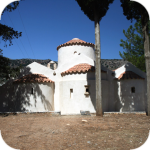
Among the olive groves in the place called Logari, which is less than a kilometer from the village of Kritsa, there is a small Byzantine church of Panagia Kera from the 13th-14th centuries. It is probably one of the most famous sacred monuments in Crete. Of the hundreds of other similar churches, Panagia Kera is distinguished by rich polychromes decorating the entire interior. An interesting fact is that the Byzantine frescoes, which can now be admired, have been hidden under plaster for hundreds of years. Former Christians hid their presence to protect them from destruction by the Turkish occupant. Frescos were rediscovered only in 1971.

The Church of the Blessed Virgin Mary with the Golden Step dating from the seventeenth century is the westernmost sacred building of this type, 9 kilometers away from Elafonissi. There is no way to overlook the convent leading to this monastery, because Hrisoskalitissas is about half a kilometer from the main road leading from Kissamos towards Elafonisi. It is worth joining this church with a rest on the most famous beach of Crete. The main advantage of Hrisoskalitissas, for which it is worth seeing it is a beautiful location on the top of a rock rising steeply over the sea shore.
Komentarze
Po raz pierwszy byliśmy tam we wrześniu 2011, dwukrotnie
Raz przyjechaliśmy samochodem do Agios Ioanis skąd zeszliśmy szlakiem - prowadzi w dół prawie kilometrowego klifu, ale jest poprowadzony zakosami - po dojściu zwiedziliśmy plaże, kościół i odpoczęliśmy w tawernie i wróciliśmy pod górę. Po kilku dniach pojechaliśmy rano do Chorej Sfakion, popłynęliśmy pierwszym promem da Aghia Roumeli ( nie byliśmy tam za wcześnie, po 12 ) i poszliśmy do Loutro, gdzie z pewnym trudem zdążyliśmy na ostatni prom do Chora Sfakion. Ale jak byśmy nie zdążyli to do zmroku spokojnie dalo by się dojść do Chorej.
Później byliśmy tam jeszcze kilkukrotnie, chcieliśmy w 2013 spać tam na plaży - byliśmy przygotowani bo wybieraliśmy się dalej do Soughii. i na Elafonisi ale jak o 18 szef tawerny przyniósł dwulitrowa bańkę raki na trzy osoby to wymieniliśmy i po kilku kolejkach powiedzieliśmy że musimy iść do Aghia Roumeli by rano iść dalej. Dopiero w 2016 biwakowalismy tam trzy dni - wtedy też był ten sam szef, ale jego młody pomocnik który poznał nas powiedział że szef jest niestety poważnie chory i nie może pić.Ale też pamiętał że byliśmy u niego kilka razy.
komentarz z
Coś dla piechurów. Leży na cudownym szlaku E4
Wypełnij poniższy formularz aby dodać komentarz
lub kliknij w poniższy link aby skorzystać z możliwosci komentowania przez facebooka:
https://www.facebook.com/crete.poland/posts/10158389994582551